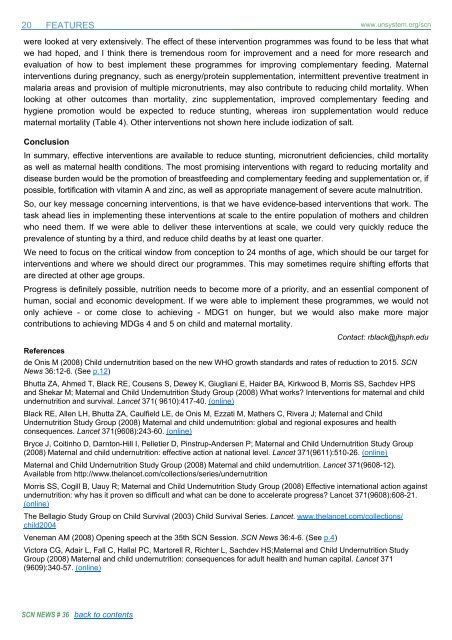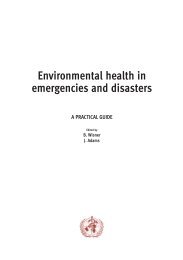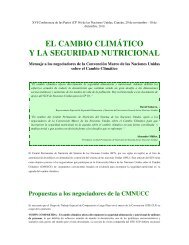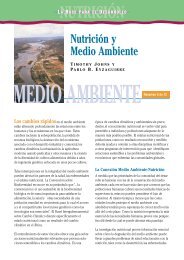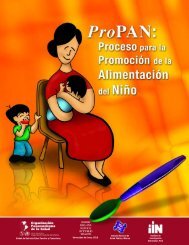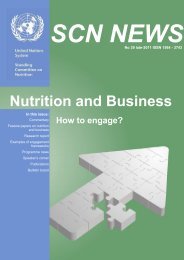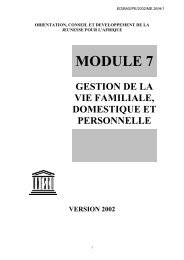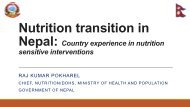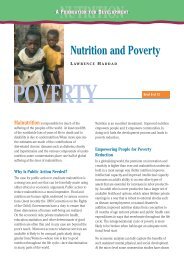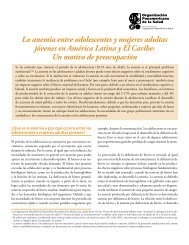SCN News No 36 - UNSCN
SCN News No 36 - UNSCN
SCN News No 36 - UNSCN
You also want an ePaper? Increase the reach of your titles
YUMPU automatically turns print PDFs into web optimized ePapers that Google loves.
20<br />
FEATURES<br />
www.unsystem.org/scn<br />
were looked at very extensively. The effect of these intervention programmes was found to be less that what<br />
we had hoped, and I think there is tremendous room for improvement and a need for more research and<br />
evaluation of how to best implement these programmes for improving complementary feeding. Maternal<br />
interventions during pregnancy, such as energy/protein supplementation, intermittent preventive treatment in<br />
malaria areas and provision of multiple micronutrients, may also contribute to reducing child mortality. When<br />
looking at other outcomes than mortality, zinc supplementation, improved complementary feeding and<br />
hygiene promotion would be expected to reduce stunting, whereas iron supplementation would reduce<br />
maternal mortality (Table 4). Other interventions not shown here include iodization of salt.<br />
Conclusion<br />
In summary, effective interventions are available to reduce stunting, micronutrient deficiencies, child mortality<br />
as well as maternal health conditions. The most promising interventions with regard to reducing mortality and<br />
disease burden would be the promotion of breastfeeding and complementary feeding and supplementation or, if<br />
possible, fortification with vitamin A and zinc, as well as appropriate management of severe acute malnutrition.<br />
So, our key message concerning interventions, is that we have evidence-based interventions that work. The<br />
task ahead lies in implementing these interventions at scale to the entire population of mothers and children<br />
who need them. If we were able to deliver these interventions at scale, we could very quickly reduce the<br />
prevalence of stunting by a third, and reduce child deaths by at least one quarter.<br />
We need to focus on the critical window from conception to 24 months of age, which should be our target for<br />
interventions and where we should direct our programmes. This may sometimes require shifting efforts that<br />
are directed at other age groups.<br />
Progress is definitely possible, nutrition needs to become more of a priority, and an essential component of<br />
human, social and economic development. If we were able to implement these programmes, we would not<br />
only achieve - or come close to achieving - MDG1 on hunger, but we would also make more major<br />
contributions to achieving MDGs 4 and 5 on child and maternal mortality.<br />
Contact: rblack@jhsph.edu<br />
References<br />
de Onis M (2008) Child undernutrition based on the new WHO growth standards and rates of reduction to 2015. <strong>SCN</strong><br />
<strong>News</strong> <strong>36</strong>:12-6. (See p.12)<br />
Bhutta ZA, Ahmed T, Black RE, Cousens S, Dewey K, Giugliani E, Haider BA, Kirkwood B, Morris SS, Sachdev HPS<br />
and Shekar M; Maternal and Child Undernutrition Study Group (2008) What works? Interventions for maternal and child<br />
undernutrition and survival. Lancet 371( 9610):417-40. (online)<br />
Black RE, Allen LH, Bhutta ZA, Caulfield LE, de Onis M, Ezzati M, Mathers C, Rivera J; Maternal and Child<br />
Undernutrition Study Group (2008) Maternal and child undernutrition: global and regional exposures and health<br />
consequences. Lancet 371(9608):243-60. (online)<br />
Bryce J, Coitinho D, Darnton-Hill I, Pelletier D, Pinstrup-Andersen P; Maternal and Child Undernutrition Study Group<br />
(2008) Maternal and child undernutrition: effective action at national level. Lancet 371(9611):510-26. (online)<br />
Maternal and Child Undernutrition Study Group (2008) Maternal and child undernutrition. Lancet 371(9608-12).<br />
Available from http://www.thelancet.com/collections/series/undernutrition<br />
Morris SS, Cogill B, Uauy R; Maternal and Child Undernutrition Study Group (2008) Effective international action against<br />
undernutrition: why has it proven so difficult and what can be done to accelerate progress? Lancet 371(9608):608-21.<br />
(online)<br />
The Bellagio Study Group on Child Survival (2003) Child Survival Series. Lancet. www.thelancet.com/collections/<br />
child2004<br />
Veneman AM (2008) Opening speech at the 35th <strong>SCN</strong> Session. <strong>SCN</strong> <strong>News</strong> <strong>36</strong>:4-6. (See p.4)<br />
Victora CG, Adair L, Fall C, Hallal PC, Martorell R, Richter L, Sachdev HS;Maternal and Child Undernutrition Study<br />
Group (2008) Maternal and child undernutrition: consequences for adult health and human capital. Lancet 371<br />
(9609):340-57. (online)<br />
<strong>SCN</strong> NEWS # <strong>36</strong> back to contents


